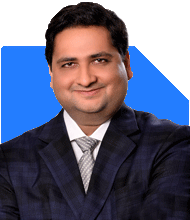As a 34-year-old investing for 10 years, am I on the right track?
Ramalingam Kalirajan |10870 Answers |Ask -Follow
Mutual Funds, Financial Planning Expert - Answered on Jul 27, 2024
He has an MBA in finance from the University of Madras and is a certified financial planner.
He is the director and chief financial planner at Holistic Investment, a Chennai-based firm that offers financial planning and wealth management advice.... more

Hi Ulhas ... I am investing in below mutual fund as SIP every month for long term like 10 years to built a significant corpus. Kindly let me know if these funds are good ? Any good suggestion on diversification and how much corpus i can expect in 10 years. Apart from that i have investment in PPF , Sukanya samridhi yojana, NPS etc. 1. Parag parikh flexi cap fund - 10000 rs. 2. UTI Nifty 50 fund - 3000 rs. 3. quant mid cap fund - 4000 rs. 4. quant small cap fund - 2500 rs. 5. Mirae asset large and mid cap fund - 4000 rs.
Your current investment strategy includes a mix of large-cap, mid-cap, and small-cap funds. This diversified approach is commendable.
Parag Parikh Flexi Cap Fund: Flexi cap funds are versatile. They invest across market capitalisations, offering good potential for growth.
UTI Nifty 50 Fund: This is an index fund. It tracks the Nifty 50 index, providing stable returns. However, it lacks flexibility compared to actively managed funds.
Quant Mid Cap Fund: Mid-cap funds offer higher growth potential. They are suitable for long-term wealth creation.
Quant Small Cap Fund: Small-cap funds can deliver significant returns. They are riskier but beneficial for long-term goals.
Mirae Asset Large and Mid Cap Fund: This fund balances stability and growth. It invests in both large and mid-cap stocks.
Suggestions for Diversification
Your portfolio already has a good mix. Here are some suggestions for further diversification:
Balanced Allocation: Ensure a balanced allocation across different market caps. Avoid over-concentration in any single category.
Sectoral Funds: Consider adding sectoral funds. They invest in specific sectors, offering diversification across industries.
Aggressive Hybrid Funds: These funds provide a mix of equity and debt. They balance risk and reward.
Benefits of Actively Managed Funds
Flexibility: Actively managed funds adapt to market changes. They can outperform passive index funds.
Strategic Management: Fund managers make informed decisions. They aim to maximise returns while managing risks.
Disadvantages of Index Funds:
No Flexibility: Index funds cannot adapt to market conditions. They simply replicate the index.
Limited Potential: They often provide average returns. They do not outperform the market.
Direct Funds vs. Regular Funds
Disadvantages of Direct Funds:
Lack of Guidance: Direct funds do not offer professional advice. You might miss strategic insights.
Benefits of Regular Funds:
Professional Advice: Investing through a Certified Financial Planner (CFP) ensures expert guidance.
Comprehensive Service: Regular funds provide portfolio management and financial planning.
Estimating Your Corpus in 10 Years
Based on your current SIPs, let's estimate your potential corpus in 10 years:
Parag Parikh Flexi Cap Fund: Rs. 10,000 per month
UTI Nifty 50 Fund: Rs. 3,000 per month
Quant Mid Cap Fund: Rs. 4,000 per month
Quant Small Cap Fund: Rs. 2,500 per month
Mirae Asset Large and Mid Cap Fund: Rs. 4,000 per month
Assuming an average annual return of 12-15%, your investments could grow significantly. However, this is an estimate. Actual returns may vary based on market conditions.
Additional Investment Options
Balanced Advantage Funds: These funds dynamically adjust their allocation between equity and debt. They manage risk effectively.
International Funds: Consider international funds for global exposure. They diversify your portfolio beyond domestic markets.
Final Insights
Your current SIP strategy is well-diversified and aligned with long-term wealth creation. Consider adding sectoral and balanced advantage funds for further diversification. Actively managed funds provide flexibility and strategic management. Avoid over-reliance on index funds. Review your portfolio regularly and seek professional guidance for optimal results.
Best Regards,
K. Ramalingam, MBA, CFP
Chief Financial Planner,
www.holisticinvestment.in
You may like to see similar questions and answers below
Nikunj Saraf | Answer |Ask -Follow
Mutual Funds Expert - Answered on Apr 19, 2023
Ulhas Joshi |280 Answers |Ask -Follow
Mutual Fund Expert - Answered on Apr 10, 2023
Hardik Parikh | Answer |Ask -Follow
Tax, Mutual Fund Expert - Answered on Apr 06, 2023
Ramalingam Kalirajan |10870 Answers |Ask -Follow
Mutual Funds, Financial Planning Expert - Answered on Apr 05, 2023
Hardik Parikh | Answer |Ask -Follow
Tax, Mutual Fund Expert - Answered on May 03, 2023
Dr Dipankar Dutta |1837 Answers |Ask -Follow
Tech Careers and Skill Development Expert - Answered on Dec 05, 2025
Dr Shyam Jamalabad |108 Answers |Ask -Follow
Dentist - Answered on Dec 05, 2025
Dr Shyam Jamalabad |108 Answers |Ask -Follow
Dentist - Answered on Dec 05, 2025
Dr Shyam Jamalabad |108 Answers |Ask -Follow
Dentist - Answered on Dec 05, 2025
Dr Dipankar Dutta |1837 Answers |Ask -Follow
Tech Careers and Skill Development Expert - Answered on Dec 05, 2025
Ulhas Joshi |280 Answers |Ask -Follow
Mutual Fund Expert - Answered on Dec 05, 2025
Dr Dipankar Dutta |1837 Answers |Ask -Follow
Tech Careers and Skill Development Expert - Answered on Dec 04, 2025
Ravi Mittal |676 Answers |Ask -Follow
Dating, Relationships Expert - Answered on Dec 04, 2025
Anu Krishna |1745 Answers |Ask -Follow
Relationships Expert, Mind Coach - Answered on Dec 04, 2025
Anu Krishna |1745 Answers |Ask -Follow
Relationships Expert, Mind Coach - Answered on Dec 04, 2025


























